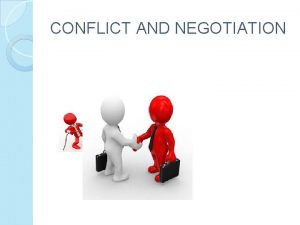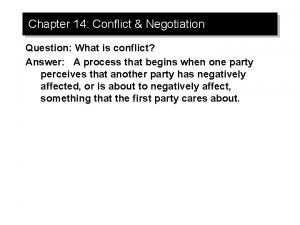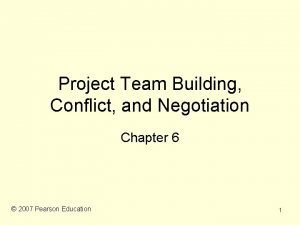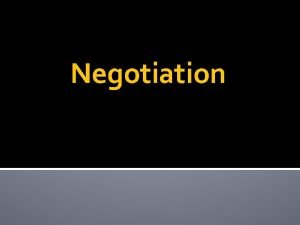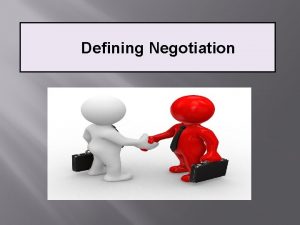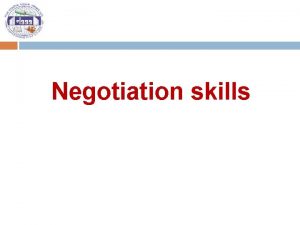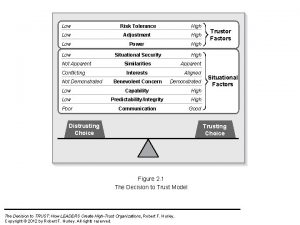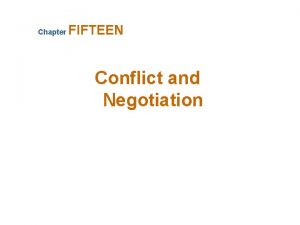Conflict Management Negotiation Managing Conflict Performance High Low













- Slides: 13

Conflict Management & Negotiation

Managing Conflict: Performance High Low Complacency Managed Conflict Intense

Definitions Conflict – Interaction of persons who perceive incompatible goals and interference from one another in achieving those goals Negotiation – A process in which two or more parties attempt to reach acceptable agreement in a situation characterized by some level of disagreement.

KEY STEPS ¶ Analyze Situation – – – Identify your needs Importance—Is it worth it? Zero-sum Strength of position Future Interactions? Ë Analyze other party(ies) – Real needs, interests – Strengths/Weaknesses – Their styles/approach Ì Select Appropriate Approach – Conflict Style – Negotiation (Integrative, Distributive)

Styles of Conflict Resolution Aggressive Competition (forcing) Satisfy Self? (Manager exerting authority) Collaboration (Marriage Counselors/Labor mediation) Compromise (Union-Management) Passive Avoidance Accommodation Uncooperative Cooperative (Most common approach) (Acquiescent Parent) Satisfy Other? (Cooperativeness)

INTEGRATIVE NEGOTIATION Conditions – Generally best – Win-Win is possible – Opponent is willing

DISTRIBUTIVE NEGOTIATING Conditions – Zero-sum game – Opponent is distributive – You have the power – Relationship not critical

DISTRIBUTIVE STRATEGIES Identify target and resistance points – Goal? – Start moderately high/low, make concession, get stingy – View initial offers as a starting point Persuasion Leverage Power: Facts, Experience, position Fairness Emotions Closed Manage Perceptions

INTEGRATIVE NEGOTIATION Conditions – Generally best – Win-Win is possible – Opponent is willing Key? Integrative Strategies?

INTEGRATIVE NEGOTIATION Integrative Strategies – – – – Openness Trust Flexibility Begin Positively Focus on the Issue Remain Rational Use objective criteria

Styles of Conflict Resolution Aggressive Competition (forcing) Satisfy Self? (Manager exerting authority) Collaboration (Marriage Counselors/Labor mediation) Compromise (Union-Management) Passive Avoidance Accommodation Uncooperative Cooperative (Most common approach) (Acquiescent Parent) Satisfy Other? (Cooperativeness)

CHOOSING A STYLE Competition (forcing) – – – Time is an important constraint Issue is unpopular/action must be taken Commitment is not critical Competitive others You have the power Collaboration – – Too important for compromise Time pressures are minimal All want win-win Communication-based

CHOOSING A STYLE Avoidance – – Issue is trivial Costs/disruptions outweigh benefits Problem may solve itself Based on personal differences Accommodation – Issue is more important to the other party – Stockpile Credits – Minimize loss Compromise – Equal power with exclusive goals – Temporary solution to a complex issue – Tight time constraints
 Managing conflict and negotiation
Managing conflict and negotiation Mid = (low + high) / 2
Mid = (low + high) / 2 Managing negotiation
Managing negotiation Conflict and negotiation
Conflict and negotiation Negotiation in the workplace
Negotiation in the workplace Chapter 14 conflict and negotiation
Chapter 14 conflict and negotiation Negotiation team building
Negotiation team building Negotiation conflict styles by calum coburn
Negotiation conflict styles by calum coburn Emotive communication style
Emotive communication style High precision vs high accuracy
High precision vs high accuracy Low voltage hazards
Low voltage hazards Performance management vs performance appraisal
Performance management vs performance appraisal Behaviorally anchored rating scales
Behaviorally anchored rating scales Managing employee performance and reward
Managing employee performance and reward



